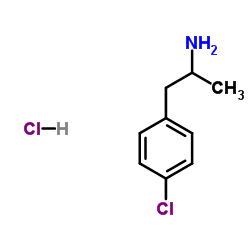(-)-p-Chloroamphetamine hydrochloride

(-)-p-Chloroamphetamine hydrochloride structure
|
Common Name | (-)-p-Chloroamphetamine hydrochloride | ||
|---|---|---|---|---|
| CAS Number | 3706-38-5 | Molecular Weight | 206.112 | |
| Density | N/A | Boiling Point | 244.2ºC at 760mmHg | |
| Molecular Formula | C9H13Cl2N | Melting Point | 168-170ºC(lit.) | |
| MSDS | USA | Flash Point | 117ºC | |
| Symbol |

GHS06 |
Signal Word | Danger | |
|
Pyrrolidone carboxylic acid levels or caspase-14 expression in the corneocytes of lesional skin correlates with clinical severity, skin barrier function and lesional inflammation in atopic dermatitis.
J. Dermatol. Sci. 76(3) , 231-9, (2014) Dry skin in atopic dermatitis (AD) mainly results from barrier impairment due to deficiency of ceramide and natural moisturizing factors including pyrrolidone carboxylic acid (PCA) in stratum corneum (SC). Caspase-14 cleaves filaggrin monomers to free amino a... |
|
|
Metabolic imaging of pancreatic ductal adenocarcinoma detects altered choline metabolism.
Clin. Cancer Res. 21(2) , 386-95, (2015) Pancreatic ductal adenocarcinoma (PDAC) is an aggressive and lethal disease that develops relatively symptom-free and is therefore advanced at the time of diagnosis. The absence of early symptoms and effective treatments has created a critical need for identi... |
|
|
Organic amendments to avocado crops induce suppressiveness and influence the composition and activity of soil microbial communities.
Appl. Environ. Microbiol. 81(10) , 3405-18, (2015) One of the main avocado diseases in southern Spain is white root rot caused by the fungus Rosellinia necatrix Prill. The use of organic soil amendments to enhance the suppressiveness of natural soil is an inviting approach that has successfully controlled oth... |
|
|
Analysis of a plant complex resistance gene locus underlying immune-related hybrid incompatibility and its occurrence in nature.
PLoS Genet. 10(12) , e1004848, (2014) Mechanisms underlying speciation in plants include detrimental (incompatible) genetic interactions between parental alleles that incur a fitness cost in hybrids. We reported on recessive hybrid incompatibility between an Arabidopsis thaliana strain from Polan... |
|
|
Application of chemometric algorithms to MALDI mass spectrometry imaging of pharmaceutical tablets.
J. Pharm. Biomed. Anal. 105 , 91-100, (2015) During drug product development, the nature and distribution of the active substance have to be controlled to ensure the correct activity and the safety of the final medication. Matrix assisted laser desorption/ionization mass spectrometry imaging (MALDI-MSI)... |
|
|
Cluster analysis of commercial samples of Bauhinia spp. using HPLC-UV/PDA and MCR-ALS/PCA without peak alignment procedure.
Phytochem. Anal. 26 , 367-73, (2015) Bauhinia forficata Link. is recognised by the Brazilian Health Ministry as a treatment of hypoglycemia and diabetes. Analytical methods are useful to assess the plant identity due the similarities found in plants from Bauhinia spp. HPLC-UV/PDA in combination ... |
|
|
Automatic UPDRS Evaluation in the Sit-to-Stand Task of Parkinsonians: Kinematic Analysis and Comparative Outlook on the Leg Agility Task.
IEEE. J. Biomed. Health. Inform. 19 , 803-14, (2015) In this study, we first characterize the sit-to-stand (S2S) task, which contributes to the evaluation of the degree of severity of the Parkinson's disease (PD), through kinematic features, which are then linked to the Unified Parkinson's disease rating scale ... |
|
|
Differentiation of Aurantii Fructus Immaturus from Poniciri Trifoliatae Fructus Immaturus using flow-injection mass spectrometric (FIMS) metabolic fingerprinting method combined with chemometrics.
J. Pharm. Biomed. Anal. 107 , 251-7, (2015) A flow-injection mass spectrometric metabolic fingerprinting method in combination with chemometrics was used to differentiate Aurantii Fructus Immaturus from its counterfeit Poniciri Trifoliatae Fructus Immaturus. Flow-injection mass spectrometric (FIMS) fin... |
|
|
Determination of Sudan I in paprika powder by molecularly imprinted polymers-thin layer chromatography-surface enhanced Raman spectroscopic biosensor.
Talanta 143 , 344-52, (2015) Sudan I is a carcinogenic and mutagenic azo-compound that has been utilized as a common adulterant in spice and spice blends to impart a desirable red color to foods. A novel biosensor combining molecularly imprinted polymers (MIPs), thin layer chromatography... |
|
|
Data-driven signal-resolving approaches of infrared spectra to explore the macroscopic and microscopic spatial distribution of organic and inorganic compounds in plant.
Anal. Bioanal. Chem 407 , 5695-706, (2015) The nondestructive and label-free infrared (IR) spectroscopy is a direct tool to characterize the spatial distribution of organic and inorganic compounds in plant. Since plant samples are usually complex mixtures, signal-resolving methods are necessary to fin... |